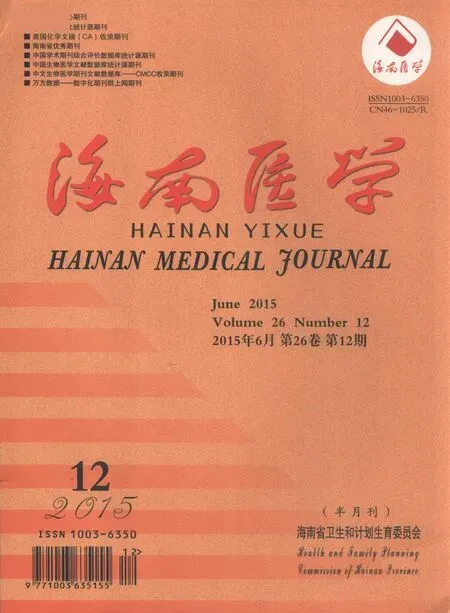Epac信号分子与哮喘关系研究进展
2015-03-20黄革高亚东
黄革,高亚东
(武汉大学中南医院呼吸内科,湖北武汉430071)
Epac信号分子与哮喘关系研究进展
黄革,高亚东
(武汉大学中南医院呼吸内科,湖北武汉430071)
支气管哮喘是临床常见的气道慢性炎症性疾病,以气道高反应性、慢性气道炎症和气道重塑为病理生理特征,其发病机制目前尚未完全阐明。环磷酸腺苷(cAMP)是体内重要的第二信使,参与调控机体新陈代谢、细胞钙信号传导、细胞生长与分化、凋亡等多种病理生理过程。长期以来,蛋白激酶A(PKA)被认为是介导cAMP生物学效应的唯一下游信号分子。但新近发现的新型cAMP靶分子——cAMP直接激活的交换蛋白(Epac)的发现打破了这一说法。大量研究证实,Epac可单独或协同PKA介导cAMP的多种生物学效应。本文就Epac在支气管哮喘发病中的作用及其可能机制作一综述,为寻找哮喘治疗新靶点奠定基础。
支气管哮喘;环磷酸腺苷;cAMP直接激活的交换蛋白;蛋白激酶A
支气管哮喘(简称哮喘)是临床常见的气道慢性炎症性疾病,以气道高反应性、炎症及重塑为重要特征[1],且发病率呈逐年上升趋势[2]。目前,哮喘的治疗以缓解症状和控制急性发作为主。β2受体激动剂、磷酸二酯酶抑制剂等作为哮喘治疗的一线药物,其疗效已被广泛认同,作用机制主要是通过升高细胞内cAMP水平。PKA一直被认为是cAMP下游唯一的效应分子,介导cAMP的多种生物学效应,直到1998年分别发表在Nature和Science的两项研究发现cAMP直接激活的交换蛋白(Exchange protein directly activated by cAMP,Epac)分子才改变了这一观念[3-4]。Epac作为新型cAMP靶分子,可单独或协同PKA介导cAMP的多种生物学效应。本文将主要介绍Epac在哮喘发病中的作用及其可能的机制。
1 新型cAMP靶分子——Epac
Epac主要功能是作为小G蛋白Rap1的特异性鸟嘌呤核苷酸交换因子(Guanine nucleotide exchange factor,GEF),将Rap1结合的GDP(无活性)置换为GTP(有活性),活化后的Rap1进一步对各项生理活动起调控作用。Epac被证实存在两种亚型:Epac1和Epac2,两者在包括肺在内的许多组织器官均有表达[3-4],且在不同器官及器官的不同发育阶段的表达量存在明显差异[5]。Epac在结构上包括调节区和催化区,前者含有高亲和力的cAMP结合位点,后者含有一特异性的CDC25同源结构域(CDC25 homology domain,CDC25-HD),CDC25-HD具有GEF活性,可活化一系列信号分子,如Rap1、Rap2、PKB/Akt、Rho、R-Ras等,进一步调控细胞生长、分化、粘附及凋亡等多种细胞生命活动[6]。Epac作为一个多功能信号分子,对免疫、呼吸、神经、心血管及内分泌等多个系统功能有其独特的调控作用[7-8]。
2 Epac与哮喘
哮喘是多种细胞、细胞组分及炎症介质引起的气道慢性炎症性疾病,伴随气道阻塞和气道结构改变(即气道重塑)。大量研究表明,Epac参与哮喘气道高反应性、炎症及重塑进程,在哮喘的发病中发挥重要作用。
2.1 Epac调控气道反应性气道高反应性(Airway hyperresponsibility,AHR)是哮喘基本特征之一。尽管关于AHR发生机制的研究已取得较大进展,但其确切机制目前尚未完全阐明,参与的机制包括:Th细胞作用失衡;平滑肌细胞增生与肥大;黏液过度分泌;嗜酸粒细胞等多种炎症细胞、炎症介质和细胞因子的作用等。虽然AHR形成机制复杂多样,但气道平滑肌(Airway smooth muscle,ASM)在其中所起作用是毋庸置疑的。cAMP激动剂如β2受体激动剂缓解哮喘支气管痉挛的作用已被广泛认同,大多数观点认为PKA介导了这一效应[9]。但也有研究表明,cAMP激动剂产生的舒张支气管作用非PKA依赖性[10]。不乏证据表明Epac参与其中,有研究证实Epac可将RhoA/Rac1平衡点向Rac1偏移,从而降低ASM肌球蛋白轻链(Myosin light chain,MLC)磷酸化水平,介导ASM舒张[11]。另有Zieba等[12]研究发现,Epac可通过下调RhoA活性诱导ASM松弛。RhoA、Rac1皆属Rho GTPase家族,Rho GTPase可通过调控肌动-肌球蛋白细胞骨架影响细胞运动,在ASM收缩与舒张活动中起重要作用。气道黏液的过度分泌与AHR的形成密切相关。气道上皮细胞电解质的跨膜转运(如Cl-的分泌)在气道黏液的清除中发挥积极作用。Lau等[13]研究表明,Epac可增强二磷酸尿苷(Uridine diphosphate,UDP)诱导的人上皮细胞Cl-的分泌活动,从而促进黏液的清除,减轻气道高反应性。
2.2 Epac调控气道炎症慢性气道炎症在哮喘的发生中占重要地位,越来越多的研究表明Epac在哮喘炎症过程中发挥重要作用,且同时表现出抗炎和促炎作用。细胞屏障功能在抑制炎症的扩散中发挥重要作用。有研究显示,Epac可通过活化小G蛋白Rap1/Rac维持肺血管内皮细胞功能稳定[14],从而阻止炎症的扩散。Vang等[15]研究发现,Epac参与了cAMP对效应T细胞的抑制作用。另有Zaslona等[16]研究表明,Epac抑制了Th2型细胞因子IL-13的生成。Epac经PKB/Akt和GSK-3信号途径,抑制细菌脂多糖(Lipopolysaccaride,LPS)诱导的巨噬细胞IFN-β的分泌[17]。Jing等[18]研究发现,Epac通过活化PKB/GSK信号途径抑制了树突状细胞(Dendritic cell,DC)分泌趋化因子CCL3和CCL4,从而发挥抗炎效应。腺苷(Adenosine)可通过与各种炎症细胞表面的腺苷受体A2a(A2aR)结合发挥抗炎效应,Scheibner等[19]研究发现,A2aR介导的抗炎作用与Epac抑制核因子-κB (Nuclear factor-κB,NF-κB)和一些炎性基因的表达有关。除上述抗炎作用外,Epac同时表现出一定的促炎作用。哮喘时血液循环中白细胞向气道募集是炎症的主要来源之一。有研究表明,Epac-Rap1通过活化整合素β1(Integrins β1)促进了白细胞的粘附及游出[20]。Tan等[21]研究表明,Epac通过活化细胞外信号调节激酶1/2(Extracellular signal-regulated kinase 1/2,ERK1/2)和p38信号途径,促进巨噬细胞分泌IL-6和IL-1β等炎症因子。有研究显示,Epac协同PKA通过激活Rap1-ERK1/2信号途径,促进了缓激肽(Bradykinin)诱导的气道平滑肌细胞IL-8的分泌[22]。另有Nagano等[23]研究证明,Epac可通过活化Rap-PLCε信号途径,上调哮喘小鼠支气管上皮细胞炎症因子的分泌。IL-10是重要的免疫调节性因子,主要功能为抑制炎症反应和调控免疫细胞的分化和增殖。有研究表明,Epac可抑制外周血单个核细胞(Peripheral blood mononuclear cell,PBMC)分泌IL-10[24],间接的促进了炎症反应。因此,Epac作为一个多功能信号分子,可通过不同的信号途径,在哮喘中同时发挥着抗炎及促炎作用。
2.3 Epac调控气道重塑有些哮喘患者承受持续症状以及进行性肺功能降低,对其气道进行组织学检查,往往会发现气道发生了明显的结构改变,包括气道上皮和网状层增厚、上皮下胶原沉积、平滑肌细胞增生肥大、黏液腺增生及新生血管形成等病理改变[25],即所谓气道重塑。气道平滑肌细胞(Airway smooth muscle cells,ASMCs)增生与肥大是哮喘气道重塑最显著病理特征之一。ASMCs有潜在的增殖、迁移及合成分泌功能,这也正是其导致气道重塑的主要机制。Kassel等[26]研究表明,Epac参与β2受体激动剂抑制ASMCs的增殖效应。ASMCs在丝裂原刺激下会发现表型转换,由收缩型转换为增殖分泌型,促进哮喘疾病的发展。有研究显示,Epac通过抑制ERK1/2转录阻止ASMCs表型转换[27],起到抗重塑作用。肺成纤维细胞在哮喘气道重塑中同样发挥重要作用。当成纤维细胞受到刺激时,可转化成肌成纤维细胞,后者可分泌大量包括Ⅰ、Ⅲ、Ⅴ型胶原蛋白及纤维连接蛋白在内的细胞外基质和促炎因子,此外成纤维细胞可分泌基质金属蛋白酶(Matrix metalloprotinease,MMP-9)及其抑制物组织性基质金属蛋白酶抑制物(Tissue inhibitor of matrix metalloproteinase,TIMP-1),MMP-9可分解细胞外基质,若MMP-9与TIMP-1失衡,会导致细胞外基质的沉积[28]。Huang等[29]研究证实,Epac1通过活化Rap1抑制了人肺成纤维细胞的增殖。同时,Haag等[30]研究证明,Epac1而非PKA抑制了人肺成纤维细胞增殖。Oldenburger等[31]研究表明,Epac1可抑制香烟烟雾诱导的气道重塑过程。因此可知,Epac可通过多种途径抑制气道重塑。
3 展望
cAMP作为重要的第二信使分子,参与调控体内多种生理病理过程。临床上常用哮喘治疗药物,如β2受体激动剂、磷酸二酯酶抑制剂、前列腺素E2等均是通过增加细胞内cAMP水平来发挥效应的。PKA作为cAMP下游效应分子参与介导cAMP的多种效应,而新近发现的Epac同样介导发挥cAMP的生物学功能。Epac有调控哮喘气道高反应性、炎症及重塑过程的作用,但在炎症方面,Epac似乎表现出相互对抗的作用,如抗炎和促炎作用,说明Epac调控疾病过程的信号途径纷繁复杂,有待研究进一步阐明。鉴于Epac在哮喘中发挥重要作用,或许在不久的将来会成为哮喘治疗的新型靶分子。
[1]Holgate ST.Pathogenesis of asthma[J].Clin Exp Allergy,2008,38 (6)∶872-897.
[2]Akinbami LJ,Moorman JE,Liu X.Asthma prevalence,health care use,and mortality∶United States,2005-2009[J].Natl Health Stat Report,2011(32)∶1-14.
[3]Kawasaki H,Springett GM,Mochizuki N,et al.A family of cAMP binding proteins that directly activate Rap1[J].Science,1998,282 (5397)∶2275-2279.
[4]de Rooij J,Zwartkruis FJ,Verheijen MH,et al.Epac is a Rap1 guanine-nucleotide-exchange factor directly activated by cyclic AMP [J].Nature,1998,396(6710)∶474-477.
[5]Ulucan C,Wang X,Baljinnyam E,et al.Developmental changes in gene expression of Epac and its upregulation in myocardial hypertrophy[J].Am J Physiol Heart Circ Physiol,2007,293(3)∶H1662-1672.
[6]Gloerich M,Bos JL.Epac∶defining a new mechanism for cAMP action[J].Annu Rev Pharmacol Toxicol,2010,50∶355-375.
[7]Grandoch M,Roscioni SS,Schmidt M.The role of Epac proteins, novel cAMP mediators,in the regulation of immune,lung and neuronal function[J].Br J Pharmacol,2010,159(2)∶265-284.
[8]Schmidt M,Dekker FJ,Maarsingh H.Exchange protein directly activated by cAMP(epac)∶a multidomain cAMP mediator in the regulation of diverse biological functions[J].Pharmacol Rev,2013,65 (2)∶670-709.
[9]Morgan SJ,Deshpande DA,Tiegs BC,et al.beta-Agonist-mediated relaxation of airway smooth muscle is protein kinase A-dependent [J].J Biol Chem,2014,289(33)∶23065-23074.
[10]Spicuzza L,Belvisi MG,Birrell MA,et al.Evidence that the anti-spasmogenic effect of the beta-adrenoceptor agonist,isoprenaline,on guinea-pig trachealis is not mediated by cyclic AMP-dependent protein kinase[J].Br J Pharmacol,2001,133(8)∶1201-1212.
[11]Roscioni SS,Maarsingh H,Elzinga CR,et al.Epac as a novel effector of airway smooth muscle relaxation[J].J Cell Mol Med,2011, 15(7)∶1551-1563.
[12]Zieba BJ,Artamonov MV,Jin L,et al.The cAMP-responsive Rap1 guanine nucleotide exchange factor,Epac,induces smooth muscle relaxation by down-regulation of RhoA activity[J].J Biol Chem, 2011,286(19)∶16681-16692.
[13]Lau WK,Chow AW,Au SC,et al.Differential inhibitory effects of CysLT(1)receptor antagonists on P2Y(6)receptor-mediated signaling and ion transport in human bronchial epithelia[J].PloS One, 2011,6(7)∶e22363.
[14]Birukova AA,Zagranichnaya T,Alekseeva E,et al.Epac/Rap and PKA are novel mechanisms of ANP-induced Rac-mediated pulmonary endothelial barrier protection[J].J Cell Physiol,2008,215(3)∶715-724.
[15]Vang AG,Housley W,Dong H,et al.Regulatory T-cells and cAMP suppress effector T-cells independently of PKA-CREM/ICER∶a potential role for Epac[J].Biochem J,2013,456(3)∶463-473.
[16]Zaslona Z,Okunishi K,Bourdonnay E,et al.Prostaglandin E(2)suppresses allergic sensitization and lung inflammation by targeting the E prostanoid 2 receptor on T cells[J].J Allergy Clin Immunol, 2014,133(2)∶379-387.
[17]Xu XJ,Reichner JS,Mastrofrancesco B,et al.Prostaglandin E2 suppresses lipopolysaccharide-stimulated ifn-beta production[J].J Immunol,2008,180(4)∶2125-2131.
[18]Jing H,Yen JH,Ganea D.A novel signaling pathway mediates the inhibition of CCL3/4 expression by prostaglandin E2[J].J Biol Chem,2004,279(53)∶55176-55186.
[19]Scheibner KA,Boodoo S,Collins S,et al.The adenosine a2a receptor inhibits matrix-induced inflammation in a novel fashion[J].Am J Respir Cell Mol Biol,2009,40(3)∶251-259.
[20]Lorenowicz MJ,Fernandez-Borja M,Hordijk PL.cAMP signaling in leukocyte transendothelial migration[J].Arterioscler Thromb Vasc Biol,2007,27(5)∶1014-1022.
[21]Tan KS,Nackley AG,Satterfield K,et al.Beta2 adrenergic receptor activation stimulates pro-inflammatory cytokine production in macrophages via PKA-and NF-kappaB-independent mechanisms[J]. Cell Signal,2007,19(2)∶251-260.
[22]Roscioni SS,Kistemaker LE,Menzen MH,et al.PKA and Epac cooperate to augment bradykinin-induced interleukin-8 release from human airway smooth muscle cells[J].Respir Res,2009,10∶88.
[23]Nagano T,Edamatsu H,Kobayashi K,et al.Phospholipase cepsilon, an effector of ras and rap small GTPases,is required for airway inflammatory response in a mouse model of bronchial asthma[J]. PloS One,2014,9(9)∶e108373.
[24]Gerlo S,Verdood P,Kooijman R.Modulation of cytokine production by cyclic adenosine monophosphate analogs in human leukocytes[J].J Interferon Cytokine Res,2010,30(12)∶883-891.
[25]Lazaar AL,Panettieri RA Jr.Is airway remodeling clinically relevant in asthma?[J].Am J Med,2003,115(8)∶652-659.
[26]Kassel KM,Wyatt TA,Panettieri RA,Jr.,et al.Inhibition of human airway smooth muscle cell proliferation by beta 2-adrenergic receptors and cAMP is PKA independent∶evidence for EPAC involvement[J].Am J Physiol Lung Cell Mol Physiol,2008,294(1)∶L131-138.
[27]Roscioni SS,Dekkers BG,Prins AG,et al.cAMP inhibits modulation of airway smooth muscle phenotype via the exchange protein activated by cAMP(Epac)and protein kinase A[J].Br J Pharmacol, 2011,162(1)∶193-209.
[28]Halwani R,Al-Muhsen S,Hamid Q.Airway remodeling in asthma [J].Current opinion in pharmacology,2010,10(3)∶236-245.
[29]Huang SK,Wettlaufer SH,Chung J,et al.Prostaglandin E2 inhibits specific lung fibroblast functions via selective actions of PKA and Epac-1[J].Am J Respir Cell Mol Biol,2008,39(4)∶482-489.
[30]Haag S,Warnken M,Juergens UR,et al.Role of Epac1 in mediating anti-proliferative effects of prostanoid EP(2)receptors and cAMP in human lung fibroblasts[J].Naunyn Schmiedebergs Arch Pharmacol,2008,378(6)∶617-630.
[31]Oldenburger A,Timens W,Bos S,et al.Epac1 and Epac2 are differentially involved in inflammatory and remodeling processes induced by cigarette smoke[J].FASEB J,2014,28(11)∶4617-4628.
Research progress of the relationship between Epac and asthma.
HUANG Ge,GAO Ya-dong.Department of Respiratory Medicine,Zhongnan Hospital of Wuhan University,Wuhan 430071,Hubei,CHINA
Asthma is a chronic airway inflammatory disorder characterized by airway hyperresponsibility, chronic inflammation and airway remodeling,of which the mechanisms are not fully illustrated.Cyclic adenosine monophosphate(cAMP)is a very important second messenger which controls a range of diverse physiological or pathological processes,including metabolism,calcium signal,cell growth and differentiation,and apoptosis.Protein kinase A(PKA)had been considered as the only downstream target of cAMP.However,the recently reported target of cAMP, the exchange protein directly activated by cAMP(Epac),had changed the previous point.A large number of studies had shown that Epac regulates many biological processes either alone and(or)in concert with PKA.In this review,we will discuss the roles and probable mechanisms of Epac in asthma.
Asthma;Cyclic adenosine monophosphate(cAMP);Exchange protein directly activated by cAMP(Epac);Protein kinaseA(PKA)
R562.2+5
A
1003—6350(2015)12—1791—03
2015-01-12)
湖北省自然科学基金(编号:2014CFB202)
高亚东。E-mail:gaoyadong@gmail.com
doi∶10.3969/j.issn.1003-6350.2015.12.0641
